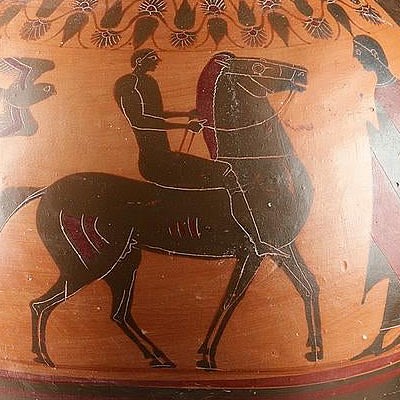Costa Rican Jade Celt - Bird Man w/ 2-Headed Serpent
Lot 135e
About Seller
Artemis Gallery
686 S Taylor Ave, Ste 106
Louisville, CO 80027
United States
Selling antiquities, ancient and ethnographic art online since 1993, Artemis Gallery specializes in Classical Antiquities (Egyptian, Greek, Roman, Near Eastern), Asian, Pre-Columbian, African / Tribal / Oceanographic art. Our extensive inventory includes pottery, stone, metal, wood, glass and textil...Read more
Estimate:
$4,000 - $6,000
Absentee vs Live bid
Two ways to bid:
- Leave a max absentee bid and the platform will bid on your behalf up to your maximum bid during the live auction.
- Bid live during the auction and your bids will be submitted real-time to the auctioneer.
Bid Increments
| Price | Bid Increment |
|---|---|
| $0 | $25 |
| $300 | $50 |
| $1,000 | $100 |
| $2,000 | $250 |
| $5,000 | $500 |
| $10,000 | $1,000 |
| $20,000 | $2,500 |
| $50,000 | $5,000 |
| $100,000 | $10,000 |
| $200,000 | $20,000 |
About Auction
By Artemis Gallery
Jun 4, 2020
Set Reminder
2020-06-04 10:00:00
2020-06-04 10:00:00
America/New_York
Bidsquare
Bidsquare : Exceptional Antiquities, Asian, Ethnographic
https://www.bidsquare.com/auctions/artemis-gallery/exceptional-antiquities-asian-ethnographic-5185
An important one-day auction featuring museum-worthy examples of Egyptian, Greek, Roman, Etruscan, Near Eastern, Far East / Asian, Pre-Columbian, African / Tribal, Oceanic, Native American, Spanish Colonial, Russian, Fossils, Ancient Jewelry, Fine Art, so much more! Artemis Gallery info@artemisgallery.com
An important one-day auction featuring museum-worthy examples of Egyptian, Greek, Roman, Etruscan, Near Eastern, Far East / Asian, Pre-Columbian, African / Tribal, Oceanic, Native American, Spanish Colonial, Russian, Fossils, Ancient Jewelry, Fine Art, so much more! Artemis Gallery info@artemisgallery.com
- Lot Description
Pre-Columbian, Costa Rica, Guanacaste-Nicoya, ca. 250 to 800 CE. Wow! An incredible jadeite celt, intricately carved and string-cut with three figures: an expressive, perhaps transformative avian shaman figure with two serpents extending below. The bird-man presents an expressive visage with a long pointed beak flanked by partially drilled, wide open round eyes. His body crouches atop the serpentine creature below with his hands and feet well delineated, and he wears a tiered, turban-like headdress with incised striations to indicate the wrappings. The bicephalic serpent presents with two heads with round eyes and slit mouths at the bottom and a long undulating, u-shaped body adorned by zigzag motifs as well as periodic divots along the sides to suggest a slithering motion. Size: 6.45" H (16.4 cm)
In the Pre-Columbian world, birds were understood as sky animals that mediated between humankind and the deities of the celestial realm. Snake/serpents provide a fascinating element of Pre-Columbian iconography as they were regarded to be a beneficial source of nourishment and at the same time quite deadly with their poisonous venom. Also important to the indigenous was the fact that snakes shed their skin annually thus rejuvenating themselves and serving as symbols of renewal and good health. The existence of two snake heads on this piece may suggest the bicephalic serpent which was a signifier of high rank in various Pre-Columbian world views. These two-headed beasts were regarded as sky bands that arched over the earth or surrounded the seas serving as a passageway for the planets and stars of the celestial realm. This motif decorated articles associated with individuals of high rank, thus associating them with the powers of this mighty creature.
The value of jade in the Pre-Columbian world lay in its symbolic power; scholars believe its color was associated with water and vegetation. Costa Rica, along with Mesoamerica, is one of the two regions where jade was extensively carved in the Pre-Columbian world. The earliest example of worked jade, a pendant excavated from a burial site on the Nicoya Peninsula, dated to the mid-first millennium BCE. It appears that jade continued to be carved into personal ornaments, usually depicting anthropomorphic deities or animals such as birds, monkeys, snakes, crocodiles, or frogs, until approximately 700 CE when gold became the favored material to fashion such ornaments.
Provenance: ex Craig Hendrix collection, South Carolina, USA; ex Charles Craig Jr. collection, Costa Rica, acquired in the 1960s and 1970s
All items legal to buy/sell under U.S. Statute covering cultural patrimony Code 2600, CHAPTER 14, and are guaranteed to be as described or your money back.
A Certificate of Authenticity will accompany all winning bids.
We ship worldwide and handle all shipping in-house for your convenience.
#154109Minute scuffs/nicks to surface commensurate with age, but otherwise intact and excellent. Drilled behind the beak for suspension. Rich deposits in the lower profile areas.Condition
- Shipping Info
-
All shipping is handled in-house for your convenience. Your invoice from Artemis Gallery will include shipping calculation instructions. If in doubt, please inquire BEFORE bidding for estimated shipping costs for individual items.
-
- Buyer's Premium



 EUR
EUR CAD
CAD AUD
AUD GBP
GBP MXN
MXN HKD
HKD CNY
CNY MYR
MYR SEK
SEK SGD
SGD CHF
CHF THB
THB














